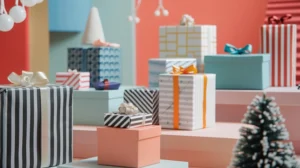Custom Packaging Design Tips: How to Create Packaging That Sells
Your packaging isn’t just a container. It’s your first impression, your brand handshake, and a silent salesperson on every shelf. With so many options out there, design can make or break a buying decision—72% of American consumers say packaging influences whether they buy a product.
If your packaging doesn’t reflect your brand story, it’s leaving money on the table. Here’s how to design packaging that grabs attention, builds trust, and keeps customers coming back.
What Should You Know About Your Brand Before Designing Packaging?
Every great design starts with clarity. Before diving into colors or materials, define what your brand stands for and who you’re talking to.
Ask yourself:
- What is my mission and core promise?
- What emotions should my packaging create?
- Who is my target customer, and what do they value most?
When your packaging aligns with your brand identity and audience expectations, it instantly feels authentic. People buy what resonates emotionally, not just what looks nice.
What Makes Product Packaging Visually Effective?
Visuals do more than look good—they communicate meaning. Every detail, from font weight to texture, shapes perception.
Use these visual design principles to make packaging work harder:
- Contrast and hierarchy direct attention to the most important info.
- Balance and proportion keep your design clean and harmonious.
- Texture and finish add tactile depth that customers remember.
Consistency across every element—color palette, typography, logo placement—builds instant brand recognition.
What’s the Best Material for Your Product Packaging?
The material you choose affects perception, cost, and usability. Match your packaging type to your product, your shipping method, and your brand personality.
Product boxes and cartons
Perfect for retail. Use premium finishes like foil, embossing, or soft-touch coating for shelf appeal.
Mailer boxes
Ideal for ecommerce or subscriptions. Strong, protective, and easy to brand inside and out.
Flexible packaging
Great for food, cannabis, or supplements. Features like resealable zippers or hang holes boost convenience.
Labels
Cost-effective and customizable. Perfect for bottles, jars, or handmade goods. Waterproof or die-cut options elevate small-batch brands.
Your choice of material should reinforce your positioning—premium, playful, natural, or sustainable.
How Can You Make Your Packaging Eco-Friendly?
Sustainability is no longer a bonus. It’s a baseline expectation. Customers notice when brands make responsible choices.
Eco-conscious packaging can:
- Reduce waste and cost through print-on-demand
- Use recycled, compostable, or biodegradable materials
- Strengthen brand perception and customer loyalty
Work with suppliers that offer low minimum orders, carbon-neutral printing, or recyclable substrates. Green choices show you’re thinking long-term—not just about sales, but about impact.
How Do You Balance Aesthetics with Functionality?
A beautiful package fails if it doesn’t perform in the real world. Your design needs to protect, inform, and delight.
Before finalizing, test your design against these questions:
- Can it survive shipping or multiple openings?
- Does it communicate key info clearly?
- Is it intuitive to open and reseal?
Pro tips:
- Use inserts or dividers for fragile products
- Prioritize durability during transit
- Keep all text legible and accessible
- Maintain visual consistency across your entire line
Form matters, but function builds trust.
How Does Packaging Design Improve the Customer Experience?
Good packaging makes life easier—and customers remember that.
Here’s how smart design adds value:
| Benefit | Why It Matters |
|---|---|
| Ease of use | Resealable or easy-open features create satisfaction |
| Perceived value | Premium design justifies higher pricing |
| Brand recognition | Cohesive visuals build long-term recall |
| Emotional connection | Personalized notes or QR codes deepen engagement |
| Business growth | Better packaging leads to repeat buyers and referrals |
Packaging is part of the product experience. Treat it that way.
What Packaging Design Trends Should You Watch in 2025?
The next wave of packaging is interactive, personalized, and sustainable.
Personalization at scale
Digital printing makes it easy to create one-of-a-kind packaging at low cost.
Interactive packaging
AR, QR codes, or sensory elements transform a box into a branded experience.
Tech-driven unboxing
Link to how-to videos, exclusive content, or upsells directly from the package.
Next-gen sustainability
Compostable, minimalist, and circular designs are becoming the new normal.
Adopt trends that support your brand story, not just because they’re popular.
How Do You Prepare Packaging Files for Print?
When it’s time to go to print, precision matters. Poor prep equals costly reprints.
Color setup
- Use CMYK (not RGB)
- Rich black: 60-40-40-100 for large areas
- Plain black: 0-0-0-100 for small text
Image quality
- Minimum 300 DPI
- Embed all images
- Outline all fonts
File format
- Submit as PDF, AI, or EPS
- Include 1/8″ bleed and safe zones
Typography
- Minimum 10pt for boxes, 6pt for labels
- Use bolder weights for knockout text
Always request a proof before printing. Fixing issues early saves time and money.
Turn Your Packaging Into a Competitive Advantage
Your packaging is more than a surface—it’s strategy in physical form. It tells your story, reflects your values, and connects your brand to your buyer in a single moment.
If you’re ready to turn packaging into a growth tool, the PackStudio team can help you design, print, and optimize packaging that performs—on the shelf and in your customer’s hands.

